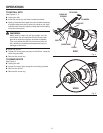
10
WARNING:
Do not allow familiarity with products to make you
careless. Remember that a careless fraction of a
second is sufficient to inflict severe injury.
WARNING:
Always wear safety goggles or safety glasses with
side shields when operating products. Failure to do
so could result in objects being thrown into your
eyes resulting in possible serious injury.
WARNING:
Do not use any attachments or accessories
not recommended by the manufacturer of this
product. The use of attachments or accessories
not recommended can result in serious personal
injury.
APPLICATIONS
You may use this product for the purposes listed below:
Hammer drilling in concrete, brick, or other masonry
Drilling in wood
Drilling in ceramics, plastics, fiberglass, and laminates
Drilling in metals
Mixing paint
SWITCH TRIGGER
See Figure 2.
To turn the drill ON, depress the switch trigger. To turn it
OFF, release the switch trigger.
VARIABLE SPEED
The variable speed switch delivers higher speed with in-
creased trigger pressure and lower speed with decreased
trigger pressure.
NOTE: You might hear a whistling or ringing noise from
the switch during use. Do not be concerned; this is a
normal part of the switch function.
DIRECTION OF ROTATION SELECTOR
(FORWARD/REVERSE)
See Figure 3.
The direction of bit rotation is reversible and is controlled
by a selector located above the switch trigger. With the drill
held in normal operating position, the direction of rotation
selector should be positioned to the left of the switch trigger
for forward drilling. The drilling direction is reversed when
the selector is to the right of the switch trigger.
CAUTION:
To prevent gear damage, always allow the chuck
to come to a complete stop before changing the
direction of rotation.
To stop the drill, release the switch trigger and allow the
chuck to come to a complete stop.
NOTE: The drill will not run unless the direction of rotation
selector is pushed fully to the left or right.
Avoid running the drill at low speeds for extended periods
of time. Running at low speeds under constant usage may
cause the drill to become overheated. If this occurs, cool the
drill by running it without a load and at full speed.
Fig. 2
SWITCH
TRIGGER
LOCK-ON
BUTTON
Fig. 3
DIRECTION OR
ROTATION SELECTOR
(FORWARD/REVERSE)
REVERSE
FORWARD
OPERATION


















